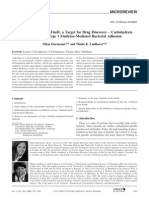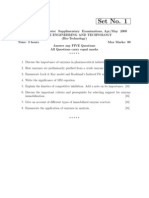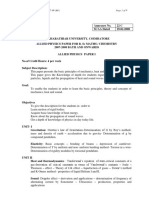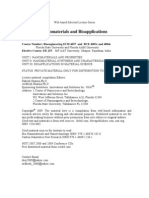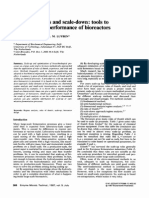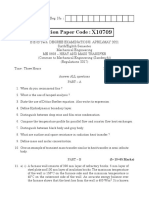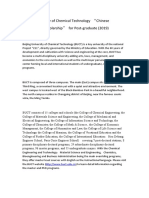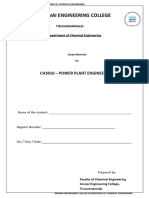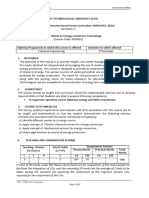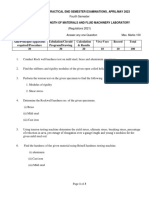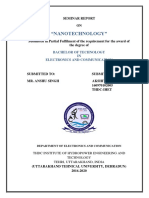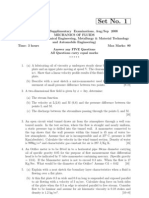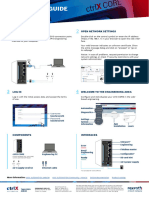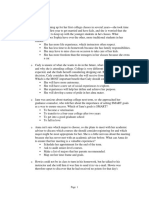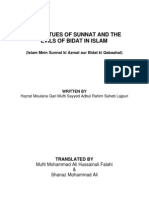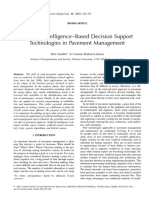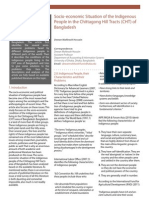FM Question Paper
FM Question Paper
Uploaded by
vijaykhannaCopyright:
Available Formats
FM Question Paper
FM Question Paper
Uploaded by
vijaykhannaOriginal Description:
Copyright
Available Formats
Share this document
Did you find this document useful?
Is this content inappropriate?
Copyright:
Available Formats
FM Question Paper
FM Question Paper
Uploaded by
vijaykhannaCopyright:
Available Formats
Reg. No.
Question Paper Code : 53084
B.E./B.Tech. DEGREE EXAMINATION, NOVEMBER/DECEMBER 2010
Third Semester
Chemical Engineering
CH 2203 FLUID MECHANICS
(Regulation 2008)
Time : Three hours
Maximum : 100 Marks
Answer ALL questions
PART A (10 2 = 20 Marks)
1.
Define non-Newtonian fluids. Give one example.
2.
An oil-storage tank has a flat, horizontal, circular roof 36 m in diameter.
Calculate the force exerted by the atmosphere on the roof.
3.
A ship having a wetted perimeter of 50 m and length of 140 m is to travel at
5 m/s. If the density of sea water is 1025 kg/m3, calculate the drag force. Take
the drag co-efficient as 0.002.
4.
Draw the velocity-radius plot in steady, laminar flow of a Newtonian fluid in a
circular pipe.
5.
Which concept is essential while designing full-size equipment from tests on
small-scale physical models?
6.
Distinguish between notches and weirs.
7.
List the minor losses encountered in pipe systems.
8.
Name the velocity ranges for which a fluidized bed can exist.
9.
Why are diaphragm pumps widely used as metering pumps?
10.
How are the steam-jet ejectors, found more useful in industrial applications?
PART B (5 16 = 80 Marks)
11.
(a)
Find the specific gravity, dynamic viscosity and kinematic viscosity of an
oil having density 981 kg/m3. The shear stress at a point in oil is
0.25 N/m2 and velocity gradient at that point is 0.2 per second. Also
determine the compressibility of the liquid, if the pressure is increased
from 0.7 MPa to 1.3 MPa while the volume decreases by 0.15 percent.
Or
(b)
A helium balloon is at the same pressure and temperature as the
surrounding air of 1 atmosphere and 20C. The diameter of the balloon is
3 m. How much payload can the balloon lift, if the weight of the plastic
skin of the balloon is negligible?
12.
(a)
A metallic ball of 0.002 m drops in a fluid of specific gravity 0.9 and
viscosity 1.5 Ns/m2. If the weight density of the ball is 120 kN/m3, find
the drag force exerted by fluid on metallic ball, the form drag, the skin
drag and the terminal velocity of ball in fluid.
Or
(b)
13.
(a)
Obtain an expression for velocity distribution in turbulent flow for
(i)
Smooth pipes and
(8)
(ii)
Rough Pipes.
(8)
State Buckinghams Pi-theorem and also explain various types of
similarities.
Or
14.
(b)
Explain the principle of venturimeter with a neat sketch and discuss the
relative merits and demerits of venturimeter with respect to orifice
meter.
(a)
A pumping plant forces water through a 600 mm diameter main, the
friction head being 27 m. In order to reduce the power consumption, it is
proposed to lay another main of appropriate diameter along the side of
the existing one, so that two pipes may work in parallel for the entire
length and reduce the friction head to 9.6 m only. Find the diameter of
the new main if, with the exception of diameter, it is similar to the
existing one in every respect.
Or
15.
(b)
Explain the fluid flow (concepts) though packed beds and fluidized beds.
(a)
Explain with neat sketches, the working of air lift pump and single
acting reciprocating pump.
Or
(b)
A centrifugal fan is used to take flue gas at rest and at a pressure of 737
mm of mercury and a temperature of 93.3C and discharge it at a
pressure of 765 mm of mercury and a velocity of 46 m/s. Calculate the
power required to move 16990 m3/hour of gas. The efficiency and
molecular weight of the gas are 65 percent and 31.3 respectively.
53084
You might also like
- Excel File CO-PO Attainment For UG - RACDocument13 pagesExcel File CO-PO Attainment For UG - RACanshul9051No ratings yet
- Aleksandar Uskokov - The Philosophy of The Brahma-Sūtra - An Introduction-Bloomsbury Academic (2022)Document241 pagesAleksandar Uskokov - The Philosophy of The Brahma-Sūtra - An Introduction-Bloomsbury Academic (2022)G G HegdeNo ratings yet
- Product Manual Pedal Interface IIDocument82 pagesProduct Manual Pedal Interface IIBjörn Van Nuffel33% (3)
- Project PPT ShubhamDocument17 pagesProject PPT ShubhamRounak Atram100% (1)
- Lindhorst T. K. Essentials of Carbohydrate Chemistry and BiochemistryDocument27 pagesLindhorst T. K. Essentials of Carbohydrate Chemistry and BiochemistryhoabkNo ratings yet
- CISA Practice Questions IT GovernanceDocument4 pagesCISA Practice Questions IT GovernanceJoeFSabater100% (1)
- Assignment Front PageDocument1 pageAssignment Front PageElamurugan PeriyasamyNo ratings yet
- Research ProposalDocument6 pagesResearch ProposalAbdalla Mohamed Abdalla100% (4)
- rr222303 Enzyme Engineering and TechnologyDocument4 pagesrr222303 Enzyme Engineering and TechnologySRINIVASA RAO GANTANo ratings yet
- Nptel PDFDocument5 pagesNptel PDFGOWTHAM GUPTHANo ratings yet
- Seminar - Nano Electro Mechanical SystemsDocument14 pagesSeminar - Nano Electro Mechanical SystemssashikantaNo ratings yet
- Allied Physics PDFDocument9 pagesAllied Physics PDFrajia1981No ratings yet
- 7th Sem ANalysis Model QUestionsDocument12 pages7th Sem ANalysis Model QUestionsDIPAK DASNo ratings yet
- Nano Materials LecturesDocument684 pagesNano Materials LecturesProf Rakesh Sharma100% (2)
- Polymeric NanoparticlesDocument28 pagesPolymeric Nanoparticlesvending machineNo ratings yet
- Ai 3302 Uoap - Lab Manual Final 23.01.2023Document56 pagesAi 3302 Uoap - Lab Manual Final 23.01.2023Shiyam Shankar S SevenNo ratings yet
- Regime Analysis and Scale DownDocument13 pagesRegime Analysis and Scale Downtiffanyyy000% (1)
- Baylor College of Medicine Cover LetterDocument4 pagesBaylor College of Medicine Cover LetterVictor AceroNo ratings yet
- PumeetDocument46 pagesPumeetDipin Preet SinghNo ratings yet
- Microbial Fuel Cell MaterialDocument364 pagesMicrobial Fuel Cell MaterialpiaNo ratings yet
- Question Paper Code:: Reg. No.Document3 pagesQuestion Paper Code:: Reg. No.Abinesh GNo ratings yet
- DIAMOND BIOSENSOR-PPT Final SeminaDocument12 pagesDIAMOND BIOSENSOR-PPT Final SeminaGurmeet AroraNo ratings yet
- Scholarship Application InformationDocument6 pagesScholarship Application InformationBedilu Belay BezulaNo ratings yet
- MRP Shemes Form New1Document19 pagesMRP Shemes Form New1khyatichavda100% (1)
- Mini Review On Nano Materials Synthesis and Applications in Metal SulphidesDocument13 pagesMini Review On Nano Materials Synthesis and Applications in Metal SulphidesInternational Journal of Innovative Science and Research TechnologyNo ratings yet
- RES Lesson PlanDocument7 pagesRES Lesson PlanarunjiboseNo ratings yet
- Bioethanol Produced From Dovyalis Caffra (Kei-Apple) by Fermentation With Yeast (Saccharomyces Cerevisiae) - Characterization, Mass & Energy BalanceDocument10 pagesBioethanol Produced From Dovyalis Caffra (Kei-Apple) by Fermentation With Yeast (Saccharomyces Cerevisiae) - Characterization, Mass & Energy BalanceIJRASETPublications100% (1)
- BIBDDocument109 pagesBIBDShikha Kashyap100% (1)
- Sample Request Form-FOR GC-MS ANALYSIS (External Users) : Soft Copy# of This Form IsDocument3 pagesSample Request Form-FOR GC-MS ANALYSIS (External Users) : Soft Copy# of This Form IsdrkameshNo ratings yet
- Solid State Physics 19UPHE02 ODD SEMDocument128 pagesSolid State Physics 19UPHE02 ODD SEMLALITHA MNo ratings yet
- Project On Gas SensorDocument30 pagesProject On Gas Sensoryoursweetom282815100% (1)
- Chy 101 Jain and JainDocument5 pagesChy 101 Jain and JainNikhil Kumar100% (1)
- Chem-E-Car Sefter Conception: Muhammad Miftahur Rahman Habib Al Aziz Fitri Handayani ArcodheaDocument16 pagesChem-E-Car Sefter Conception: Muhammad Miftahur Rahman Habib Al Aziz Fitri Handayani ArcodhearahmanNo ratings yet
- NANOTECHNOLOGY SeminarDocument30 pagesNANOTECHNOLOGY SeminarArvind Singh KasanaNo ratings yet
- Heat & Mass TransferDocument69 pagesHeat & Mass TransferRamnarayan Meena100% (2)
- Ferrite Processing: Powder Preparation-Raw Materials SelectionDocument66 pagesFerrite Processing: Powder Preparation-Raw Materials Selection吳尚謙No ratings yet
- Ece I Engineering Chemistry 15che12 Notes PDFDocument94 pagesEce I Engineering Chemistry 15che12 Notes PDFVTU PRONo ratings yet
- Outline: Fed-Batch OperationDocument21 pagesOutline: Fed-Batch OperationMuhammadHanifBinBabaNo ratings yet
- Chapter 3-Internal Mass Transfer ResistanceDocument9 pagesChapter 3-Internal Mass Transfer ResistanceSherry Anne Ynciong PanganibanNo ratings yet
- Project Proposal On Design and Modelling and Development Of: Submission DateDocument24 pagesProject Proposal On Design and Modelling and Development Of: Submission DatemuseNo ratings yet
- Composite Materials Emt311 Lecture NotesDocument63 pagesComposite Materials Emt311 Lecture NotesN.S Achyuth AnandNo ratings yet
- VTU Cryogenics Question BankDocument28 pagesVTU Cryogenics Question BankAnonymous SLKWYHBo100% (3)
- 1.full Portion SM PDFDocument109 pages1.full Portion SM PDFAditya GoleNo ratings yet
- CH3010 - Power Plant Engineering Notes .Document75 pagesCH3010 - Power Plant Engineering Notes .VijayNo ratings yet
- Model Question Paper B.Tech. Industrial Biotechnology (V Semester) Ib038 - Metabolic EngineeringDocument2 pagesModel Question Paper B.Tech. Industrial Biotechnology (V Semester) Ib038 - Metabolic Engineeringdevikamurugan124206No ratings yet
- Waste To Energy Conversion Technology Course Code: 4350502: Page 1 of 8Document8 pagesWaste To Energy Conversion Technology Course Code: 4350502: Page 1 of 8Cliches in0% (1)
- X - Ray Diffraction Technique and Diffraction Methods: Seminar OnDocument21 pagesX - Ray Diffraction Technique and Diffraction Methods: Seminar OnMohamad AlamehNo ratings yet
- Unit III - Composites Cy3151Document10 pagesUnit III - Composites Cy3151A/E5LOGESH AKRNo ratings yet
- Punjab College Pattoki: Spring 2021: Course Outline Bs Program Semester 6ThDocument8 pagesPunjab College Pattoki: Spring 2021: Course Outline Bs Program Semester 6ThFareeha ShakeelNo ratings yet
- Ce3481 Set1Document3 pagesCe3481 Set1THIRUMALAINo ratings yet
- ICT Admission Handbook 24Document370 pagesICT Admission Handbook 24Sohar MarathiNo ratings yet
- CylcotronDocument14 pagesCylcotronhey707070100% (2)
- Industrial Training Report Format (B.tech. and M.SC.) (Final)Document9 pagesIndustrial Training Report Format (B.tech. and M.SC.) (Final)musaknNo ratings yet
- Design and Development of Low-Cost Solar Dryer For Agriculture ApplicationsDocument6 pagesDesign and Development of Low-Cost Solar Dryer For Agriculture ApplicationsBhargavi KmNo ratings yet
- Nano Report PDFDocument32 pagesNano Report PDFAkshita BhargavNo ratings yet
- Thermal Engineering-II Course Code: 4351903Document12 pagesThermal Engineering-II Course Code: 4351903Het ParekhNo ratings yet
- Hyphenated TechniquesDocument23 pagesHyphenated TechniquesMuhammad KashifNo ratings yet
- CH6501 Instrumental Methods of Analysis Chemical Engineering 2015-16Document14 pagesCH6501 Instrumental Methods of Analysis Chemical Engineering 2015-16Mathavaraja JeyaramanNo ratings yet
- Fluid Mechanics QPDocument8 pagesFluid Mechanics QPCrucifiedBishwarupNo ratings yet
- FMM MODEL 2Document3 pagesFMM MODEL 2gokulspace379No ratings yet
- 12P305Document2 pages12P305RAJANo ratings yet
- r05220302 Mechanics of FluidsDocument8 pagesr05220302 Mechanics of FluidsSRINIVASA RAO GANTANo ratings yet
- Fpm Pyq 2020 December Cht205-ADocument3 pagesFpm Pyq 2020 December Cht205-AabdulganipkNo ratings yet
- GM 9984001Document3 pagesGM 9984001Felipe De la cruzNo ratings yet
- MSA 1 Summer2023Document18 pagesMSA 1 Summer2023muhammadwaiztariq6440No ratings yet
- Quick Start Guide CTRLX Core r999002047Document1 pageQuick Start Guide CTRLX Core r999002047joseluisanguianoortizNo ratings yet
- Project Document TemplateDocument5 pagesProject Document TemplateMUHAMMAD IRFANNo ratings yet
- Trends Quiz 4Document2 pagesTrends Quiz 4Ma. Fatima AlvaroNo ratings yet
- John Dewey On The True Purpose of Education and How To Harness The Power of Our Natural Curiosity - The MarginalianDocument6 pagesJohn Dewey On The True Purpose of Education and How To Harness The Power of Our Natural Curiosity - The MarginalianAyodeji KumuyiNo ratings yet
- Winning Nuclear Grade Anion Resin ZGANR140Document5 pagesWinning Nuclear Grade Anion Resin ZGANR140Jamil BadarNo ratings yet
- 5577 Project ManagementDocument14 pages5577 Project ManagementUmer Farooq50% (2)
- Midterm ExamDocument10 pagesMidterm ExamSylvia HayesNo ratings yet
- 02-Assembly Instruction Mono Rail Blow Side (ING)Document45 pages02-Assembly Instruction Mono Rail Blow Side (ING)DFSNo ratings yet
- Reflective & Creative ThinkingDocument49 pagesReflective & Creative ThinkingArooj Fatima RazaNo ratings yet
- Get Dynamical Systems and Geometric Mechanics An Introduction Jared Michael Maruskin Free All ChaptersDocument62 pagesGet Dynamical Systems and Geometric Mechanics An Introduction Jared Michael Maruskin Free All Chaptersizlabreska100% (3)
- VirtuesDocument26 pagesVirtuesapi-379914050% (2)
- Artificial Intelligence-Based Decision Support Technologies in Pavement ManagementDocument15 pagesArtificial Intelligence-Based Decision Support Technologies in Pavement Managementana majstNo ratings yet
- Marcosian RuleDocument6 pagesMarcosian RuleJanine LagutanNo ratings yet
- REVISION PAPER 2021-21 SEP Main Send 1Document12 pagesREVISION PAPER 2021-21 SEP Main Send 1Arun dasNo ratings yet
- Material Safety Datasheet HIT RE 500 EN Material Safety Datasheet IBD WWI 00000000000004566403 000Document21 pagesMaterial Safety Datasheet HIT RE 500 EN Material Safety Datasheet IBD WWI 00000000000004566403 000anggatrilaksonoputro pamitraNo ratings yet
- English: Quarter 4: Week 4 Learning Activity SheetsDocument8 pagesEnglish: Quarter 4: Week 4 Learning Activity Sheetssachi tachibanaNo ratings yet
- Module 1 Contemporary WorldDocument12 pagesModule 1 Contemporary WorldElgin Kieth D. Habac100% (2)
- Specifications and RequirementsDocument22 pagesSpecifications and RequirementsMohammed AnasNo ratings yet
- SubjectivismDocument2 pagesSubjectivismFizm Mahusay100% (1)
- 2nd Year Trinity 23-24 SDocument4 pages2nd Year Trinity 23-24 StangroNo ratings yet
- Evaluation of Bearing Capacity of Caissons Subject To ScourDocument9 pagesEvaluation of Bearing Capacity of Caissons Subject To ScourIEREKPRESSNo ratings yet
- Roadseal: Product SpecificationDocument2 pagesRoadseal: Product SpecificationSaran Kl100% (1)
- Self Diagnosis Manual Eng 04Document33 pagesSelf Diagnosis Manual Eng 04kallatis100% (1)
- ResumeDocument4 pagesResumeAjay SinghNo ratings yet
- ChittagongSocio-economic Situation of The Indigenous People in The Chittagong Hill Tracts (CHT) of BangladeshDocument9 pagesChittagongSocio-economic Situation of The Indigenous People in The Chittagong Hill Tracts (CHT) of Bangladeshshumon2657100% (2)




